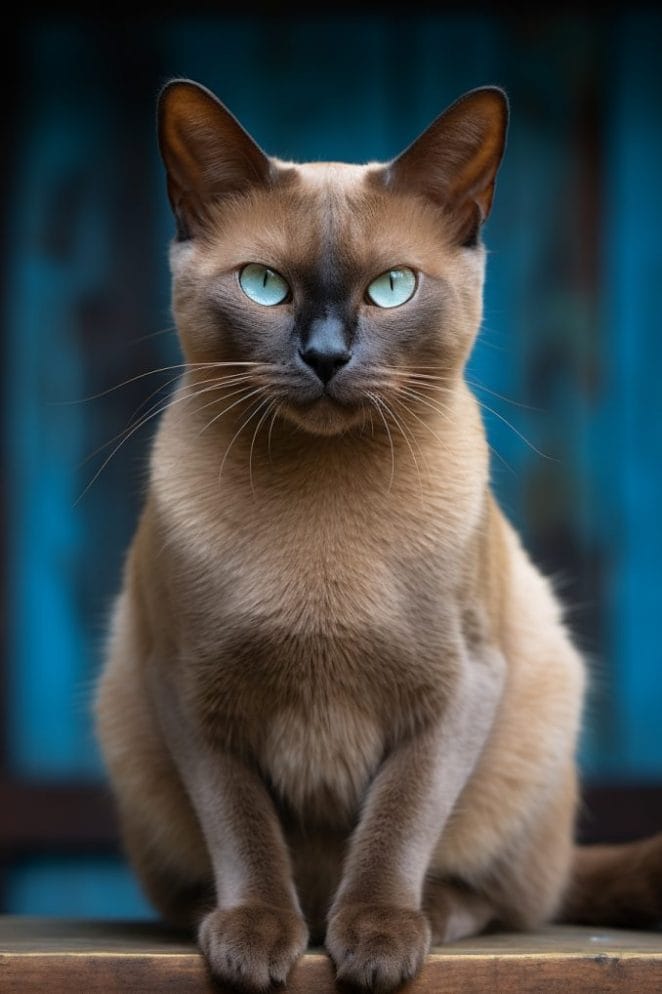
Burmese cats are not just charming companions; they are a unique feline breed with distinct behaviors that make them stand out.
In this detailed exploration, we’ll delve into the world of Burmese cat behavior, from their endearing quirks to potential challenges.
Whether you’re a proud Burmese cat parent or considering bringing one into your home, this guide is your go-to resource for understanding and navigating their captivating behaviors.
Common Burmese Cat Behaviors
Social butterflies
Burmese cats are renowned for their sociable nature, making them true social butterflies in the feline world.
They thrive on human interaction, making them ideal companions for those seeking a constant feline presence in their lives.
Expect your Burmese cat to be your faithful shadow, eagerly participating in your daily activities and forming a strong bond with you.
Playful prowess
One notable characteristic of Burmese cats is their playful prowess.
Maintaining a kitten-like enthusiasm throughout their lives, these felines are avid players.
Interactive toys and engaging playtime sessions are not just optional but essential for their overall well-being.
Intelligence and trainability
Burmese cats are highly intelligent and eager to please, making them relatively easy to train.
They can learn simple commands, such as sit, stay, and come, and some even excel in agility training.
Their intelligence also manifests in their problem-solving skills, often finding clever ways to open doors or reach desired objects.
Vocal Vibes
When it comes to communication, Burmese cats are vocal creatures.
From soft purrs to melodic meows, they utilize their vocal prowess to express themselves and engage with their human counterparts.
This verbal interaction adds a delightful and communicative aspect to the relationship, making it a unique and engaging experience for cat owners.
Warm Affection
Warmth and affection are hallmark traits of Burmese cats.
These felines enjoy cuddling and being in close proximity to their human companions.
Anticipate a warm, furry presence on your lap as you relax or a gentle companion nestled beside you during the night.

Potential Burmese Cat Behavior Challenges
Separation anxiety
Burmese cats are known for forming strong and affectionate bonds with their human companions.
Consequently, when left alone for extended periods, they may experience separation anxiety.
To address this, consider gradual desensitization by practicing short absences.
This can help your Burmese cat become more accustomed to your comings and goings, reducing stress and anxiety.
Playful nibbling
Their inherent playfulness may sometimes manifest as gentle nibbling.
While this behavior is typically a sign of affection, it’s essential to establish boundaries early on.
Encourage appropriate play and discourage nibbling on fingers or other items.
By setting clear limits, you can ensure that their playful gestures remain enjoyable without any unwanted nibbles.
Attention seekers
Burmese cats thrive on attention and may exhibit attention-seeking behaviors if they feel neglected.
To curb this tendency, prioritize regular interactive play and quality time spent together.
Engage in activities that stimulate their playful nature and provide the social interaction they crave.
A well-attended Burmese cat is likely to be content and less prone to seeking attention in disruptive ways.

Tips for Living with a Burmese Cat
Interactive playtime
Engage your Burmese cat in interactive play sessions to keep them mentally and physically stimulated.
Incorporate toys that tap into their playful instincts, such as feather wands or puzzle feeders.
This not only provides entertainment but also allows them to express their natural behaviors and instincts.
Companionship matters
Given their social nature, spending quality time with your Burmese cat is crucial.
Regular companionship helps build a strong bond and prevents feelings of loneliness.
Whether it’s interactive play, cuddle time, or simply being present in the same room, your attention contributes significantly to their well-being.
Establish routines
Burmese cats thrive on routine and predictability.
Establish a consistent feeding and play schedule to create a sense of stability in their environment.
This routine not only provides comfort but also helps them anticipate and participate in daily activities, contributing to a contented and well-adjusted cat.
Expect lively conversations
Burmese cats are known for their enthusiastic vocalizations.
Embrace their expressive meows and chirps, as they create a unique symphony of communication.
Take the time to learn and interpret their individual vocalizations, enhancing the communication and understanding between you and your feline companion.
Beware of boredom
An under-stimulated Burmese cat can resort to mischief.
Ensure a fulfilling environment with enriching activities and plenty of playthings to prevent unwanted behaviors.
Rotate toys regularly to maintain their interest, and consider introducing puzzle toys to challenge their intellect.
A stimulated Burmese cat is less likely to engage in destructive or undesirable activities.

Conclusion
Burmese cats are delightful companions, infusing any home with joy and warmth through their charming behaviors.
To cultivate a loving and harmonious relationship with your Burmese feline friend, it’s crucial to comprehend their social nature and proactively address potential challenges.
By doing so, you create an environment that not only meets their needs but also enhances the bond between you and your furry companion.
Embrace the unique qualities of Burmese cats, and enjoy the enriching experience they bring to your home.
FAQs
Yes, Burmese cats generally get along well with children, appreciating the playful interaction.
Assess their environment for potential stressors and ensure they receive ample attention and stimulation to minimize excessive vocalization.
Absolutely! Their social nature makes them adaptable to apartment living, but regular play and mental stimulation are crucial.


GIPHY App Key not set. Please check settings